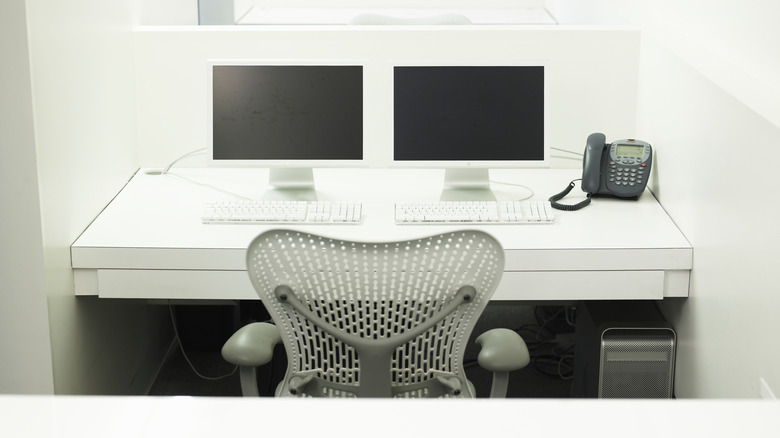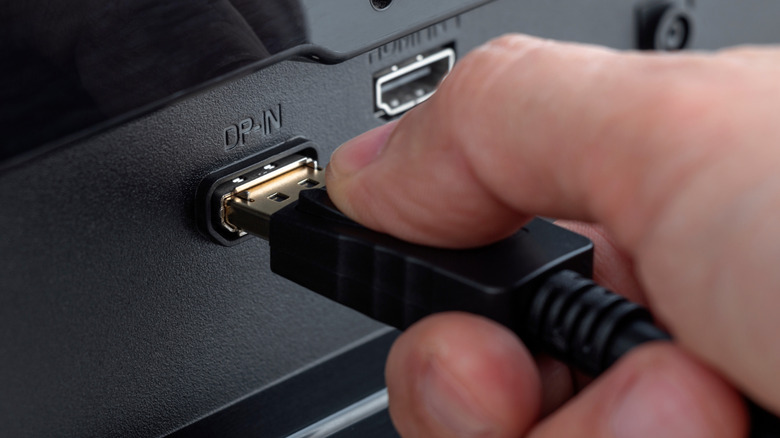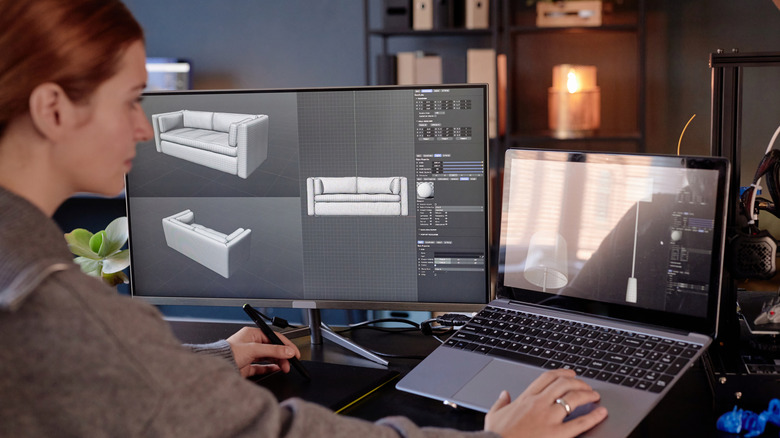How To Daisy Chain Monitors: Everything You Need To Know
We may receive a commission on purchases made from links.
Daisy chaining sounds cute — flower crowns, anyone? Alas, this has nothing to do with actual daisies. Daisy chaining is a wiring technique that lets you connect multiple devices in one "chain," meaning you don't have to plug them all in separately. In the context of monitors, this means being able to connect multiple displays to one PC while minimizing cable clutter and optimizing port usage.
While daisy chaining isn't the only method of ramping up your monitor count, it's the only one where the monitors are connected in a series, using a single output from your PC's graphics card (GPU). It's a solid option that comes in handy, especially if you're doing more than two monitors, as those cables can really get messy.
Daisy chaining monitors is definitely something that's more popular among people who use their multi-display setup for work. Gamers tend to simply use the ports on their PCs, but there are a few reasons why you might try daisy chaining instead. Below, I'll walk you through the entire process of daisy chaining so that you can turn your PC into a productivity beast.
How does daisy chaining monitors work?
Let's get into the nitty-gritty. This wiring method lets you use just one output to connect multiple monitors to the PC, but technically, only one of them is plugged into the computer — the others are connected to one another. This gives you a multi-monitor setup even if your graphics card has limited ports (or, more likely if you want to avoid desk clutter).
Most commonly, daisy chaining is done using DisplayPort technology, and it needs to be version 1.2 or above, as that's when Multi-Stream Transport (MST) was introduced. This is the magical technique that lets you use multiple completely independent video signals through one connection. One of the best things about daisy-chaining monitors is that each display can give you a different output even though they're all running on the same port. As a result, you can have a spreadsheet on one monitor, the browser on the second one, and your emails on the third one. You get the gist.
There are a couple more options for daisy chaining outside of DisplayPort 1.2 and newer. You can also daisy chain monitors by using Thunderbolt MST, meaning that all Mac users can benefit from this technique, too. If you're on Mac, make sure to check out this guide to setting up multiple monitors. There's also the option of using USB-C with DisplayPort Alt Mode (alternate mode). This essentially turns your USB-C port into a DisplayPort connection. That said, while it sounds great on paper, daisy-chaining monitors isn't for everyone. One of the main roadblocks you might run into is compatibility.
Daisy chaining with DisplayPort
Using DisplayPort 1.2 and above is the most popular way to daisy chain monitors. Doing it is as easy as pie, but there's some prep involved as you'll need to check whether your computer can support this type of connection. Before attempting to do this, make sure that your PC ticks some of the most important boxes. For starters, your graphics card and all monitors support DisplayPort 1.2 or higher.
As long as you got your monitor within the last 10 years, it should have DP 1.2, but check the spec sheet to be sure. Your GPU and monitors also need to support Multi-Stream Transport (MST), and they need to have enough bandwidth to handle multiple screens, especially if you're using monitors with higher resolutions, such as 1440p displays. Lastly, remember that daisy chaining with DisplayPort only works on Windows — macOS users need to use Thunderbolt. Follow these steps to set up your displays:
-
Grab a DisplayPort cable, like this 4K Cable Matters cord, and connect the first monitor to your computer. Make sure you're plugging it into your graphics card.
-
Use another DisplayPort cable to connect to the next monitor. Do this by plugging into the DisplayPort Output (DP Out) of the first monitor to the DisplayPort Input (DP In) of the second display.
Advertisement -
Repeat the above step if you're using a three-monitor setup.
-
Next, right-click on your desktop and go into Display Settings.
-
In the Multiple displays section, choose between Extend these displays and Duplicate. The former lets you use each monitor independently (which is what I recommend) and the latter makes them all display the same image.
You're all set! Power on all the monitors and test your new setup. We recommend running all of the software you typically run to let your PC break a sweat.
Using Thunderbolt or USB-C
Thunderbolt is the DisplayPort alternative in Apple computers, and setting up your Mac with daisy chaining is pretty straightforward. In the case of Thunderbolt, use Thunderbolt 3 or higher for optimal performance, and make sure the monitors and your computer both support that technology. The steps below apply both to Thunderbolt connections and USB-C with DisplayPort Alt Mode PCs and Macs.
-
Make sure all hardware is compatible with Multi-Stream Transport (MST) and that there are both input and output ports on all monitors.
-
Connect one end of the cable to the Thunderbolt or USB-C port on your PC.
-
Plug the other end into the monitor.
-
Connect another Thunderbolt or USB-C cable, chaining it from the output port of the first monitor to the input port of the second monitor.
-
Rinse and repeat based on however many screens you want to set up.
If you're on a Mac, your next step is to open System Preferences and then head to Displays. Under the Arrangement tab, decide which display goes where. Using Thunderbolt ensures that macOS will extend your monitors according to your desired arrangement.
Daisy chaining monitors: Pros and cons
Daisy chaining monitors is pretty good, but it's not for everyone. Many people choose to plug multiple monitors separately, directly into their GPU. However, for workstations, daisy chaining is one of the easiest ways to get yourself set up with multiple screens without much hassle—provided that your PC can support it. Daisy chaining monitors can significantly reduce cable clutter — all of your monitors are chained together, so there's technically just one cable on your desk. It's also a solid workaround if you have limited video outputs. It's also easy to expand and add another screen without having to worry about whether your PC has enough ports. Lastly, it might be cheaper than connecting each screen separately (although this depends on your video outputs).
It's not all sunshine and rainbows (or daisies), though. Daisy chaining monitors come with some significant drawbacks. Most of all, daisy chaining splits the total bandwidth of a single DisplayPort/Thunderbolt connection, which effectively means that running high resolutions and higher refresh rates becomes challenging. That's why this method is more popular for workstations.
Due to the above, gamers tend to shy away from daisy chaining. Latency and performance issues are both common in such setups. Moreover, adaptive sync technology, such as Nvidia's G-Sync and AMD's FreeSync, doesn't always function reliably when the monitors are daisy chained. Finally, there are a lot of compatibility boxes your PC and monitor both need to tick for this to work.
Can you daisy chain monitors with HDMI?
Outside of DisplayPort, most modern monitors and PCs also support HDMI connections — but unfortunately, chances are that you won't be able to use these for daisy chaining. HDMI does not support daisy chaining monitors, and while it's not entirely impossible, it'll often be more trouble than it's worth.
If you want to use multiple monitors with HDMI, the easiest way to do this is to just plug them directly into the graphics card, each using a different port. However, there are some hubs that make it possible to split a Thunderbolt or DisplayPort signal to multiple HDMI-based monitors. These hubs are often referred to as HDMI MST hubs.
HDMI splitters, like this RAVIAD 1 in 2 out splitter, are another option and work exactly how you'd imagine — they let you split the signal from one HDMI connection to multiple displays. HDMI MST hubs, like this Monoprice DisplayPort 1.2 to MST Hub work similarly: You can plug in multiple HDMI-based screens into the hub, which then connects to your PC. Before you dive in and look for these hubs and splitters, make extra sure that your monitors can support that kind of thing. Ultimately, it's probably easier to just spend some time on impeccable cable management than risk buying the wrong thing and not having a functional setup.





